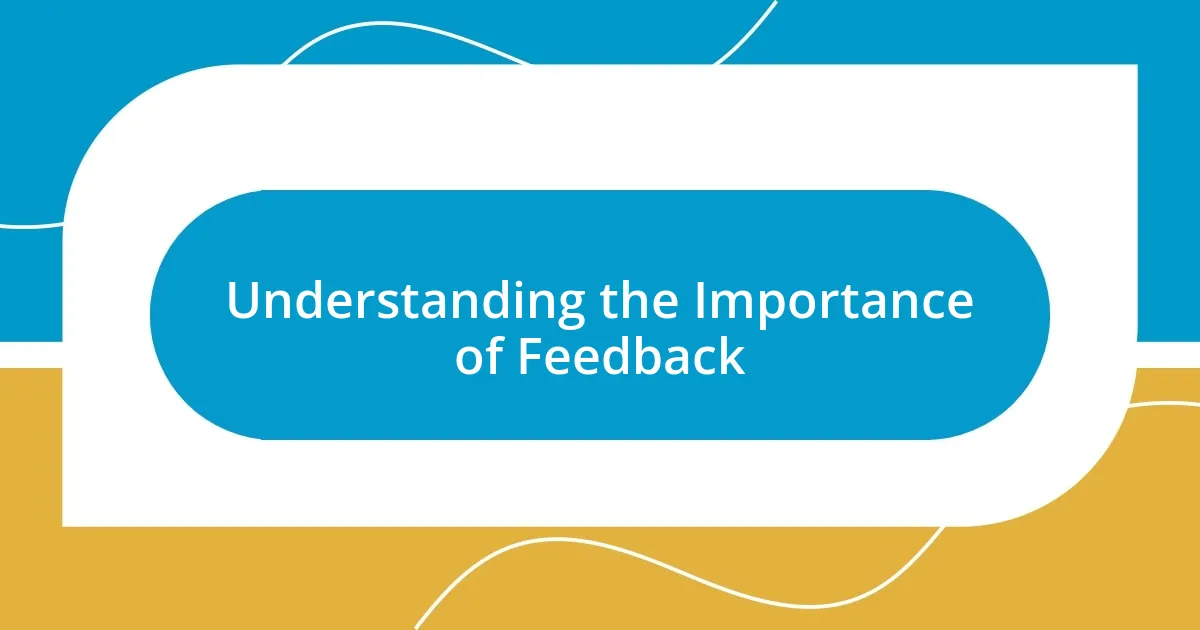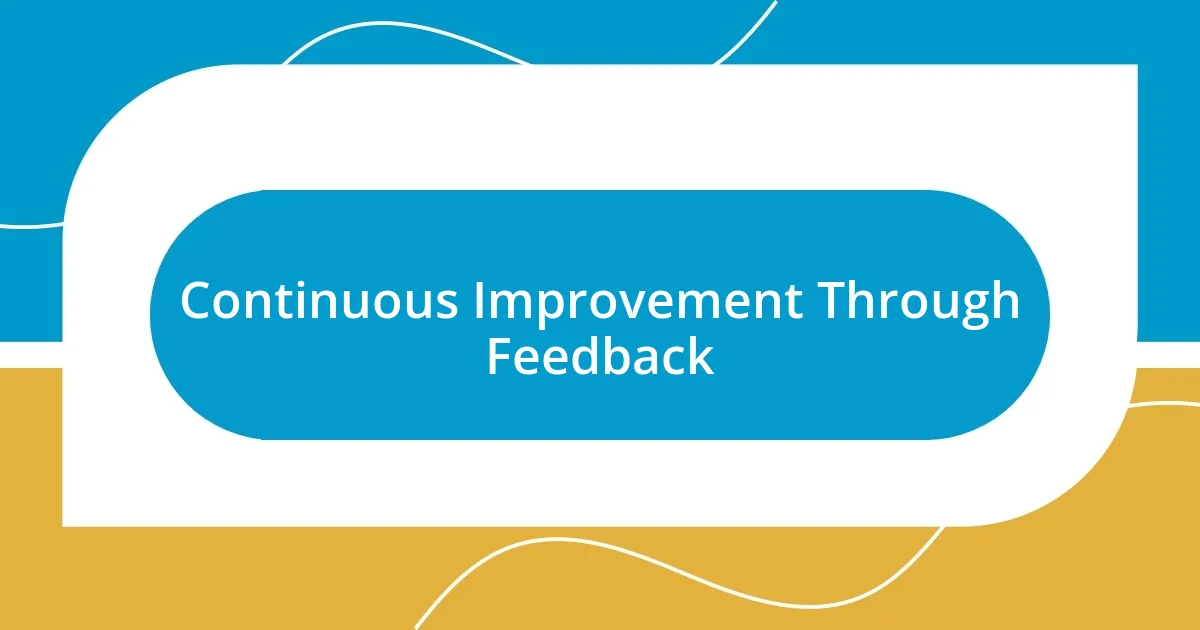Key takeaways:
- Feedback guides improvement by providing new perspectives and identifying strengths and weaknesses.
- There are three key types of feedback: formal (structured evaluations), informal (spontaneous comments), and peer (collaborative insights).
- Recognizing valuable feedback sources involves considering their expertise, perspective, and openness to honesty.
- Creating a continuous feedback loop enhances collaboration, innovation, and personal growth through ongoing dialogue.

Understanding the Importance of Feedback
Feedback is like a compass guiding us through our work, pointing out areas for improvement and highlighting our strengths. I remember a time when I received detailed feedback on a project I was passionate about. Initially, I felt defensive—I had poured my heart into it. But as I processed the comments, I realized that this feedback opened my eyes to perspectives I hadn’t considered. How often do we miss these valuable insights when we’re too focused on our own vision?
Moreover, feedback fosters a culture of growth and learning. I think back to moments in team meetings when we collectively reviewed our projects. Each person’s insights brought forth a deeper understanding of our work dynamics. It felt like we were all on a journey together, evolving and refining our skills. Don’t you think that shared learning can strengthen not just individual performance but also team cohesion?
Lastly, embracing feedback can be transformative, changing the trajectory of our work. I had a mentor who challenged me constantly, and though it was uncomfortable at times, it truly stretched my capabilities. I’ve learned that when I listen to constructive criticism, I also allow myself to grow. Can you recall a time when feedback shifted your path in a meaningful way? It’s in those moments that we truly understand the importance of inviting others into our process.

Types of Feedback for Improvement
Feedback comes in various forms, each serving its unique purpose in fostering improvement. I often categorize feedback into three types: formal, informal, and peer feedback. Formal feedback typically comes from structured evaluations or performance reviews. I remember receiving such feedback after a major presentation at work. The constructive criticism helped me refine my delivery for future engagements, making me realize just how valuable structured insights can be.
Informal feedback, on the other hand, can be more spontaneous and conversational. One time, a colleague casually mentioned how my writing style could be more engaging. Instead of feeling offended, I embraced this off-the-cuff comment. It motivated me to experiment with my tone and voice, ultimately creating a more enjoyable reading experience for my audience. Isn’t it fascinating how a simple chat can spark significant growth?
Lastly, peer feedback stands out as a powerful tool for improvement. Our team frequently engages in brainstorming sessions where we critique each other’s work. I distinctly recall a moment when a teammate pointed out a flaw in my logic during a discussion. That moment was eye-opening and reinforced the idea that we can learn immensely from those working alongside us. This collaborative feedback not only enriched my work but also strengthened our collective understanding. What has been your experience with peer feedback in enhancing your work?
| Type of Feedback | Description |
|---|---|
| Formal | Structured evaluations that provide specific insights on performance. |
| Informal | Spontaneous comments or suggestions that inspire immediate improvement. |
| Peer | Collaborative insights from colleagues that enhance understanding and skill. |

Recognizing Feedback Sources
Recognizing the right sources of feedback can significantly shape my work process. I’ve learned to identify who can offer valuable insights by considering their expertise and perspective. For instance, I once sought feedback from a colleague who had previously navigated a challenge I was facing. Their firsthand experience provided me with practical solutions that I hadn’t thought about before. It’s amazing how the right source can illuminate a path forward.
To effectively recognize feedback sources, I take note of a few key aspects:
- Expertise: I look for individuals with relevant experience or skills.
- Perspective: Diverse viewpoints can uncover blind spots I may have.
- Vulnerability: I appreciate honesty; someone who isn’t afraid to share tough feedback helps me grow.
- Engagement: Those who actively listen often provide more thoughtful and valuable feedback.
- Context: Understanding the situation can give context to the feedback, making it more actionable.
By focusing on these aspects, I can ensure that the feedback I gather is constructive and impactful. It’s a continuous journey, but the rewards are well worth the effort.

Creating a Feedback Loop
Creating a feedback loop isn’t just about collecting perspectives; it’s about establishing a dynamic where feedback flows both ways. I recall a project where I actively sought input from my team throughout the entire process, rather than just waiting for a final review. This ongoing dialogue not only improved our final product but fostered a sense of ownership among my colleagues. How often do we miss the chance to learn simply because we don’t ask for input until it’s too late?
In my experience, the consistency of feedback in a collaborative environment is essential. I often set regular check-ins where my team and I exchange thoughts, and I facilitate this by creating a safe space for open conversation. One particular instance stands out: after a round of brainstorming, one of my colleagues shared an idea that initially seemed outlandish. Encouraged by the openness of our discussion, I took a step back and realized how that unconventional thought could reshape our approach. Isn’t it amazing how we can unlock potential simply by inviting feedback throughout our work?
Ultimately, the essence of a feedback loop lies in its continuous nature. I’ve learned that the more frequently I integrate feedback into my workflow, the better I can adapt and grow. I remember feeling a bit overwhelmed after receiving feedback continuously during a high-stakes project. However, reflecting on it now, that initial discomfort transformed into a profound sense of growth. Isn’t it comforting to know that each bit of feedback, when embraced, is an opportunity waiting to be seized?

Incorporating Feedback into Work
Incorporating feedback into my work is like tuning an instrument to achieve the perfect harmony. One memorable instance was when I presented my ideas to a diverse group, and a fellow attendee highlighted a crucial flaw I hadn’t noticed. At first, I felt a tinge of defensiveness, but then I realized that their insights were a gift. It’s an eye-opener when you understand that constructive criticism isn’t a personal attack; rather, it’s a pathway to improvement.
I try to actively reflect on the feedback I receive. When someone suggests a change, I don’t just modify my work; I delve into why their perspective matters. For instance, there was a time when my approach to a project felt solid, but a mentor pointed out how my stubbornness might limit the project’s impact. As I pondered their words, I felt conflicted yet curious. What if I let go of my original vision? That inner dialogue spurred a shift in my approach, ultimately leading to a more innovative solution than I could have imagined on my own.
The beauty of incorporating feedback lies in turning vulnerability into growth. I often remind myself that sharing my work opens the door for potential critiques. They challenge me to step out of my comfort zone. It reminds me of a team initiative where I was hesitant to share my preliminary ideas. But, when I did, it sparked an enriching discussion that transformed my initial thoughts. What’s more empowering than watching your ideas evolve through collaboration? That’s when magic happens.

Measuring the Impact of Feedback
Measuring the impact of feedback requires a nuanced approach. I find myself reflecting on a time when I implemented a feedback survey after finishing a major project. The anonymity allowed my team to share insights candidly, revealing that while some aspects excelled, others fell flat. It hit me hard—how often have I assumed everything was in perfect order without actually checking?
Understanding the data from that survey was pivotal. Not only did I quantify improvements in collaboration and innovation, but I also initiated discussions around the results. It was eye-opening to see how the team engaged with the findings. I remember one colleague saying, “I didn’t realize others felt this way too!” This shared understanding created a collective drive to tackle the weaknesses head-on. Isn’t it fascinating how merely measuring feedback can foster a deeper camaraderie among colleagues?
Now, I think about the actionable steps that emerge from analyzing feedback. For example, during a recent workshop, we evaluated our collaborative tools and their effectiveness. Discovering metrics related to usage, engagement, and satisfaction highlighted areas ripe for enhancement. It’s one thing to hear feedback, but when you can pair those insights with data, it becomes a tangible plan for growth. Have you ever considered how metrics can transform your approach to feedback?

Continuous Improvement Through Feedback
Feedback is essential for continuous improvement because it creates a dynamic learning environment. I recall a project where my initial presentation received mixed reviews. Instead of feeling disheartened, I viewed it as an opportunity to refine my ideas. Gathering diverse perspectives sharpened my focus, leading to a final product that truly resonated with the audience. Have you ever experienced that exhilarating moment when a seemingly negative response becomes the catalyst for your best work?
Embracing feedback can be a humbling journey, but I’ve found it profoundly rewarding. One time, after sharing a draft, a co-worker offered insights that challenged my assumptions. Initially, my instinct was to defend my choices, but then I paused and reminded myself that their perspective might reveal blind spots I hadn’t considered. I think that moment changed how I approach feedback; I began to see every comment as a stepping stone toward greater clarity and strength in my work. Isn’t it fascinating how others can shine a light on our work in ways we never anticipated?
Ultimately, incorporating feedback fosters a culture of openness and innovation. I remember a brainstorming session that took an unexpected turn when one team member suggested a radically different direction. At first, it felt risky to embrace such a shift, but as we explored it together, the ideas evolved into something exceptional that none of us could have envisioned alone. This experience underscored a powerful lesson: collaboration fueled by feedback can unlock doors to creativity that remain closed when we work in isolation. How often do you let feedback be a guiding light in your creative process?














